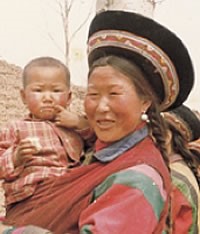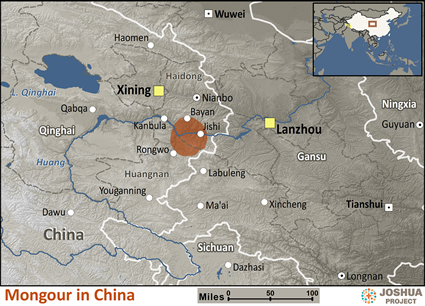When the ancestors of today's Tu and Mongour people first came to Qinghai, the area was occupied by Tibetans, Uyghurs, and a group called the Shato. By the late 1300s, the Tu had divided into 16 clans. Eight clans were called Tu (White Mongol), five Shato, one Black Mongol, one Turkish (Uyghur), and one Chinese.
Although the Mongour have been officially included as part of the Tu nationality, they speak a very different language and possess a separate identity from the Tu in other locations. As one researcher explains, "The Tu call themselves Mongol, except those living in Minhe, who form a minority, where the word is pronounced Mongour. This term has mistakenly been used by some Western scholars as the general name for all Tu."
The Mongour have several unique marriage customs. One is called "marriage to the pole" by which a girl stays with her family and takes in lovers. Any children born to her take her family's name. Another is the "marriage to the girdle" where a Mongour girl sleeps with a guest, who upon departure leaves his girdle behind. In case the girl becomes pregnant, she would be "married to the girdle." During child delivery, the mother and baby stay confined to a room for one month. Men are barred from entry; only the closest female relatives are allowed to enter.
Two types of shamans are active among the Mongour. "White shamans" are used to heal sickness, while "black shamans" bring vengeance on enemies. Another highly regarded religious figure is the kurtain. This is a person who allows himself to be possessed by an evil Daoist spirit.
By the 1920s Catholic missionaries were active in the Mongour region, but no church remains today. Most Mongour can read. Missionary Frank Laubach issued a warning to the church in the 1930s: "Millions in China will soon be reading. Are we going to give them reading matter? Will they be flooded with the message of Christ or with atheism? Will they read love or hate? This is the most stupendous, most arresting, most ominous fact, perhaps on this planet."
Without the guidance of Christ, these people are like sheep without a shepherd. They need the good shepherd in their families and communities.
Pray for the authority of Christ to bind hindering spiritual forces to lead them from darkness to light.
Pray for signs and wonders to happen among them and for great breakthroughs with a rapid multiplication of disciples and house churches.
Pray for bold workers who are driven by the love of the Holy Spirit to go to them.
Pray for an unstoppable movement to Christ among them.
Scripture Prayers for the Mongour in China.
Operation China, Asia Harvest, Copyrighted © Used with permission
| Profile Source: Joshua Project |

























